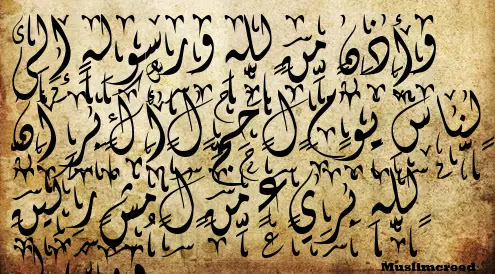The History of Giving Dots and Harakat on the Letters of the Qur’an
Muslimcreed – Giving a dot on this letter is indeed done later than giving the Quranic vows. This marking aims to distinguish between letters that have the same written form, but are pronounced differently, such as the letters ba (ب), ta (ت), tsa (ث).
In the writing of the first Ottoman manuscripts, these letters were written without using a distinguishing point. One of the lessons is to accommodate the various existing qira’at. But along with the increasing quantity of interaction between Arab Muslims and non-Arabs, errors in reading these types of letters (al-‘ujmah) also spread. This then encourages the use of this sign.
There are different opinions as to who first initiated the use of this dot for the Qur’anic manuscripts. But the strongest opinion seems to be towards Nasr bin ‘Ashim and Yahya bin Ya’mar.
It started when Caliph Abdul Malik bin Marwan ordered al-Hajjaj bin Yusuf al-Tsaqafy, the governor of Iraq at that time (75-95 H), to provide a solution to the ‘plague’ of al-‘ujmah in the community. Al-Hajjaj also chose Nahsr bin ‘Ashim and Yahya bin Ya’mar for this mission, because both of them were the most skilled in language and qira’at.
After going through various considerations, the two then decided to revive the nuqath al-i’jam tradition (giving dots to distinguish the pronunciation of letters that have the same shape). The al-ihmal and al-i’jam methods emerged. The implementation is as follows:
To distinguish between dal (د) and dzal (ذ), ra’ (ر) and zay (ز), shad (ص) and dhad (ض), tha’ (ط) and zha’ (ظ), and ‘ain ( ) and ghain (غ), then the first letters of each pair are ignored without a dot (al-ihmal), while the second letters are given a dot above it (al-i’jam).
For the pair sin (س) and syn (ش), the first letter is ignored without a dot. While the second letter (syin) is given three dots. This is because this letter has three ‘teeth’, and adding a dot above it will make it the same as the letter nun. The same consideration also causes different points to be given to the letters ba’ (ب), ta (ت), tsa (ث), nun (ن), and ya’ (ي).
For the series of letters jim (ج), ha’ (ح), and kha’ (خ), the first and third letters are given a period, while the second is ignored. While the pair fa’ (ف) and qaf (ق), should follow the previous rules, the first one is ignored and the second one is given one point above it.
It’s just that the Muslims in the Eastern Islamic region are more likely to give one upper point for fa’ and two upper points for qaf. Unlike the Muslims who are in the Islamic West (Maghrib), they give one point below for fa’, and one point above for qaf.
Nuqath al-I’jam or this dot was originally a circle, then developed into a cube shape, then a circle with a hole in the middle. This dot is written in the same color as the letter, so that it is not the same and can be distinguished from the harakat sign (nuqath al-i’rab) which is generally red.
And this tradition continued until the end of the reign of the Umayyad Caliphate and the establishment of the Abbasid Caliphate in 132 H. At this time, there were many creations in the use of color for punctuation marks in the manuscripts.
In Medina, they used black ink for letters and nuqath al-i’jam, and red ink for harakat. In Andalusia, they use four colors: black for letters, red for harakat, yellow for hamzah, and green for hamzah al-washl.
There are even some private manuscripts that use different colors to distinguish the type of i’rab of a word. But all of them almost agreed to use black ink for letters and nuqath al-i’jam, although it was different for the others.
Finally, the manuscripts of the manuscripts were colorful. But here comes another problem. As has been explained, both nuqath al-i’rab and nuqath al-i’jam, both are written in the same form, namely circular. This seems to be a new source of confusion in distinguishing one letter from another.
This is where history records the role of Khalil bin Ahmad al-Farahidy (d.170 H). He then determined the form of fathah with the lowercase alif letter lying on top of the letter, kasrah with a small ya’ letter below it and dhammah with a small waw letter above it. Meanwhile, tanwin is formed by duplicating the writing of each of these signs, in addition there are several other signs.
Related to this, there is a unique historical fact, namely that the dot (nuqath al-i’jam) was already known in the ancient pre-Islamic Arabic tradition or at least in early Islam before the Ottoman manuscripts were written.
There are several ancient discoveries that show this, including: First, the tombstone of Raqusy (at Mada’inSalih), the oldest pre-Islamic Arabic inscription, supposedly written in 267 AD. This tombstone records a dot above the letters. dal, ra’ and syin. Second, documentation in two languages on papyrus paper, the year 22 H (now stored in the Austrian National Library). This documentation shows the use of dots for the letters nun, kha, dzal, syin, and zay.
Coupled with several other findings, at least until the year 58 H. There are 10 letter characters marked with a period, namely: nun, kha, dzal, syin, zay, ya, ba, tsa, fa, and ta. So it is appropriate to conclude that what Nasr bin ‘Ashim and Yahya bin Ya’mar did was an attempt to revive the tradition with several new innovations that were tailored to the needs.
May Allah ta’ala forgive the previous scholars who have given their knowledge to all of us… aaammiiinn
WallahuA’lam.

